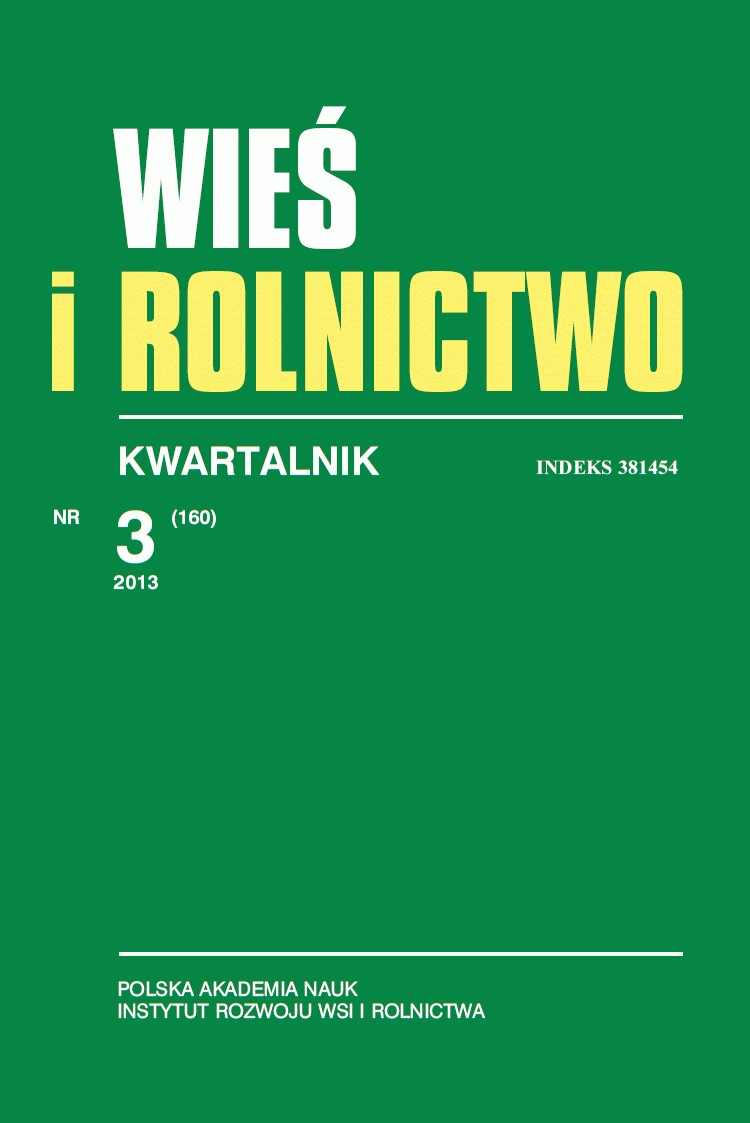Relations between agicultural information sources – website analysis
DOI:
https://doi.org/10.53098/wir.2013.3.160/10Keywords:
agriculture, knowledge transfer, internet, hyper-linksAbstract
The aim of article is to show the links between websites of entities that are important from the perspective of providing information and knowledge to farmers. Based on the analysis of hyper-links we determined the relationships between analysed websites. Assuming that the hyper-links contained in the websites are intended to refer the reader / user to another site as containing content relevant and related websites, we can determine if the institutions / entities operate in a network (allowing quick access to complementary information). Based on research we could distinguish several important aspects of links between the analysed websites. Firstly, the website of the Ministry of Agriculture and Rural Development is the main hub. Secondly, there are stronger links within the same types of institutions than between different categories of websites.References
Barabási A.L., 2003: Linked: How Everything is Connected to Everything Else and What It Means. Plume, New York.
Barabási A.L., 2007: The architecture of complexity. “IEEE Control Systems Magazine” 4: 33−42. DOI: https://doi.org/10.1109/MCS.2007.384127
Barabási A.L., Bonabeau E., 2003: Scale − Free Networks. “Scientific American” 288: 50−59. DOI: https://doi.org/10.1038/scientificamerican0503-60
Boschma R., 2005: Proximity and Innovation: a Critical Assessment. “Regional Studies” 39: 61−74. DOI: https://doi.org/10.1080/0034340052000320887
Boschma R., Lambooy J.G., 1999: Evolutionary Economics and Economic Geography. “Journal of Evolutionary Economics” 9: 411−429. DOI: https://doi.org/10.1007/s001910050089
De Maeyer J., 2012: Towards a hyperlinked society: A critical review of link studies. New Media & Society (forthcoming). DOI: https://doi.org/10.1177/1461444812462851
Etzkowitz H., Leydesdorff L., 2000: The Dynamics of Innovation: from National System and ‘Mode 2’ to a Triple Helix of University – Industry − Government Relations. “Research Policy” 29: 109−123. DOI: https://doi.org/10.1016/S0048-7333(99)00055-4
Floriańczyk Z., Czapiewski K., Stawicka E., 2007: Rural technology transfer in transition economies in Poland. Report for CEEC AGRI POLICY project. AgriPolicy.net.
Gertler M.S., 2003: Tacit knowledge and the economic geography of context, or the undefinable tacitness of being (there). “Journal of Economic Geography” 3: 75−99. DOI: https://doi.org/10.1093/jeg/3.1.75
Halavais A., 2012: Wyszukiwarki internetowe a społeczeństwo. Wydawnictwo Naukowe PWN, Warszawa.
Harries G., Wilkinson D., Price L., Fairclough R., Thelwall M., 2004: Hyperlinks as a data source for science mapping. “Journal of Information Science” 30: 436−447. DOI: https://doi.org/10.1177/0165551504046736
Ingwersen P., Björneborn L., 2005: Methodological issues of webometric studies. “Handbook of Quantitative Science and Technology Research” 2: 339−369. DOI: https://doi.org/10.1007/1-4020-2755-9_16
Janc K., 2011: Geografia hiperlinków – przestrzenny wymiar samorządowych serwisów internetowych. „Studia Regionalne i Lokalne” 4 (46): 30−50.
Janc K., 2012: Possibilities of hyperlink application in spatial research. “Bulletin of Geography. Socio-economic Series” 17 (1): 57−65. DOI: https://doi.org/10.2478/v10089-012-0006-4
Johnson T.G., 2001: The Rural Economy in a New Century. “International Regional Science Review” 24: 21−37. DOI: https://doi.org/10.1177/016001701761012953
Kania J., 2007: Doradztwo rolnicze w Polsce w świetle potrzeb i doświadczeń zagranicznych. Zeszyty Naukowe Akademii Rolniczej im. Hugona Kołłątaja w Krakowie. Rozprawy 318. Wydawnictwo Akademii Rolniczej, Kraków.
Kania J., Drygas M., Kutkowska B., Kalinowski J., 2011: System transferu wiedzy dla sektora rolno-spożywczego – oczekiwane kierunki rozwoju. “Polish Journal of Agronomy” 7: 22–28.
Khan G.F., Park H.W., 2011: Measuring the triple helix on the web: Longitudinal trends in the university-industry-government relationship in Korea. “Journal of the American Society for Information Science and Technology” 62: 2443–2455. DOI: https://doi.org/10.1002/asi.21595
Maggioni M.A., Uberti T.E., 2009: Knowledge networks across Europe: which distance matters? “Annals of Regional Science” 43: 691−720. DOI: https://doi.org/10.1007/s00168-008-0254-7
Malecki E.J., 2003: Digital development in rural areas: potentials and pitfalls. “Journal of Rural Studies” 19: 201−214. DOI: https://doi.org/10.1016/S0743-0167(02)00068-2
Malecki E.J., Moriset B., 2008: The Digital Economy. Business organization, production processes, and regional development. Routledge, Oxon.
Mitchell M., 2009: Complexity: A Guided Tour. Oxford University Press, New York. DOI: https://doi.org/10.1093/oso/9780195124415.001.0001
Nonaka I., Takeuchi H., 1995: The knowledge-creating company. How Japanese companies create the dynamics of innovation. Oxford University Press, New York. DOI: https://doi.org/10.1093/oso/9780195092691.001.0001
Nowak P., 2008: Bibliometria. Webometria. Podstawy. Wybrane zastosowania. Wydawnictwo Naukowe UAM, Poznań.
Ortega J.L., Aguillo I.F., 2008: Linking patterns in European Union countries: geographical maps of the European academic web space. “Journal of Information Science” 35: 705−714. DOI: https://doi.org/10.1177/0165551507086990
Ortega J.L., Aguillo I.F., 2009: Mapping word-class universities on the web. “Information Processing & Management” 45: 272−279. DOI: https://doi.org/10.1016/j.ipm.2008.10.001
Park H.W., 2010: Mapping the e-science landscape in South Korea using the webometrics method. “Journal of Computer-Mediated Communication” 15: 211−229. DOI: https://doi.org/10.1111/j.1083-6101.2010.01517.x
Réka A., Jeong H., Barabási A.L., 1999: Diameter of the World-Wide Web. “Nature” 401 (6749): 130−131. DOI: https://doi.org/10.1038/43601
Thelwall M., 2002: The top 100 linked-to pages on UK university web sites: high inlink counts are not usually associated with quality scholarly content. “Journal of Information Science” 28: 483−491. DOI: https://doi.org/10.1177/016555150202800604
Thelwall M., Tang R., Price L., 2003: Linguistic patterns of academic Web use in Western Europe. “Scientometrics” 56: 417−432. DOI: https://doi.org/10.1023/A:1022387105904
Törnqvist G., 2004: Creativity in Time and Space. “Geografiska Annaler, B: Human Geography” 86: 227−244. DOI: https://doi.org/10.1111/j.0435-3684.2004.00165.x
Tsvetovat M., Kouznetsov A., 2011: Social Network Analysis for Startups: Finding connections on the social web. O’Reilly Media, Sebastopol.
Vaughan L., Kipp M.E.I., Gao Y., 2007: Why are Websites co-linked? The case of Canadian universities. “Scientometrics” 72: 81−92. DOI: https://doi.org/10.1007/s11192-007-1707-y
Warren M., 2007: The digital vicious cycle: Links between social disadvantage and digital exclusion in rural areas. “Telecommunications Policy” 31: 374−388. DOI: https://doi.org/10.1016/j.telpol.2007.04.001
Downloads
Article file downloads
Pages
How to Cite
Issue
Section
License
Copyright (c) 2013 Wieś i Rolnictwo

This work is licensed under a Creative Commons Attribution 4.0 International License.










